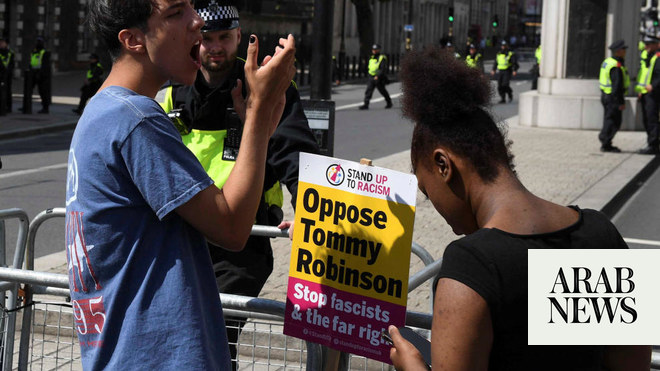DHAKA: Bangladesh police have released from hospital and arrested the leaders of a student protest that sparked nationwide unrest last week when security forces clashed with demonstrators.
Since the beginning of July, students have been demonstrating against a regulation that reserves the majority of government jobs for the descendants of those who fought in the country's war of independence in 1971.
At least 209 people were killed and thousands injured, local media reports said, after protests turned violent last week.
Most of the casualties were reported in Dhaka, where fierce clashes broke out between protesters, government supporters, police and paramilitary troops after communications were cut off across the country for six days.
Among the injured were student leaders Nahid Islam and Asif Mahmud, coordinators of Students Against Discrimination, the main protest organizing group. They were patients at Dhaka's Gonoshasthya Hospital, where they were arrested by the Dhaka Metropolitan Police's Criminal Investigation Department on Friday night. Another student leader who was visiting Islam and Mahmud, Abu Baker Majumder, was also arrested.
Criminal Investigation Department chief Harun Or-Rashid told reporters in Dhaka on Saturday that the trio were arrested “on security grounds” as their families were concerned for their safety.
“We have taken them into our care to ensure their safety,” he said.
The student leaders were arrested by a group of more than a dozen plainclothes police officers despite objections from medical staff, a hospital official told Arab News.
“At first we tried to explain to them that patients admitted without appropriate measures cannot leave the hospital. Later they spoke to our authorities and the students were taken out of the hospital. We could not keep them any longer,” said the hospital worker, who wished to remain anonymous.
“The health of the students was not so good… Asif was struggling with low blood pressure and Nahid was suffering from blood clots and bruises on various parts of his body. Both of them needed further treatment.”
The arrests come as part of a police raid in Dhaka, where a curfew imposed last week remains in effect.
Liton Kumar Saha, deputy commissioner of Dhaka Metropolitan Police, said 2,284 people had been arrested in Dhaka in connection with the protests, during which numerous administrative offices were set on fire.
“We analyze the footage from different locations and identify the perpetrators. If we receive confirmation that someone was involved in the anarchy, we carry out operations to arrest him. We have done this with transparency and are checking the people who were involved in the sabotage,” he told Arab News.
“In the last 24 hours, 245 people were arrested in Dhaka. Our campaign will continue until the situation returns to normal.”
International human rights groups have repeatedly raised concerns about Bangladesh's handling of the protests. Amnesty International said witness accounts and video and photographic evidence “confirm the use of unlawful force by the police against protesting students.”
The protests broke out after the Supreme Court upheld a controversial quota system under which 56 percent of public sector jobs were reserved for certain groups, including women, marginalized groups and children and grandchildren of freedom fighters, for whom the government earmarks 30 percent of the jobs.
The Supreme Court last week rolled back the quota system and ordered that 93 percent of government jobs be awarded on the basis of merit.
